A High-Gain Circularly Polarized Magnetoelectric Dipole Antenna Array for Millimeter-Wave Applications
Abstract
1. Introduction
2. ME-Dipole Antenna Array Design
2.1. Proposed CP Antenna Element Design
2.1.1. Analysis of the Proposed CP ME-Dipole
2.1.2. Parametric Studies
2.2. 4 × 4 Antenna Array Design
2.2.1. Design of the 2 × 2 CP ME-Dipole Antenna Subarray
2.2.2. Design of the 4 × 4 Antenna Array
3. Experimental Results
4. Discussion
5. Conclusions
Author Contributions
Funding
Data Availability Statement
Conflicts of Interest
Abbreviations
| CP | Circularly polarized |
| ME-dipole | Magnetoelectric dipole |
| MMW | Millimeter-wave |
| SIW | Substrate-integrated waveguide |
| LP | Linearly polarized |
| LHCP | Left-hand circularly polarized |
| AR | Axial ratio |
References
- Deslandes, D.; Wu, K. Integrated microstrip and rectangular waveguide in planar form. IEEE Microw. Compom. Lett. 2001, 11, 68–70. [Google Scholar] [CrossRef]
- Li, Y.; Chen, Z.N.; Qing, X.; Zhang, Z.; Xu, J.; Feng, Z. Axial ratio bandwidth enhancement of 60-GHz substrate integrated waveguide-fed circularly polarized LTCC antenna array. IEEE Trans. Antennas Propag. 2012, 60, 4619–4626. [Google Scholar] [CrossRef]
- Wu, J.; Cheng, Y.J.; Fan, Y. Millimeter-wave wideband high-efficiency circularly polarized planar array antenna. IEEE Trans. Antennas Propag. 2016, 64, 535–542. [Google Scholar] [CrossRef]
- Liu, C.; Guo, Y.-X.; Bao, X.; Xiao, S.-Q. 60-GHz LTCC integrated circularly polarized helical antenna array. IEEE Trans. Antennas Propag. 2012, 60, 1329–1335. [Google Scholar] [CrossRef]
- Zhang, T.; Zhang, Y.; Cao, L.; Hong, W.; Wu, K. Single-layer wideband circularly polarized patch antennas for Q-Band applications. IEEE Trans. Antennas Propag. 2015, 63, 409–414. [Google Scholar] [CrossRef]
- Zhu, Q.; Ng, K.-B.; Chan, C.H. Printed circularly polarized spiral antenna array for millimeter-wave applications. IEEE Trans. Antennas Propag. 2017, 65, 636–643. [Google Scholar] [CrossRef]
- Zhang, L.; Wu, K.; Wong, S.W.; He, Y.; Chu, P.; Li, W.; Wang, K.X.; Gao, S. Wideband high-efficiency circularly polarized SIW-fed s-dipole array for millimeter-wave applications. IEEE Trans. Antennas Propag. 2020, 68, 2422–2427. [Google Scholar] [CrossRef]
- Zhang, Y.-X.; Jiao, Y.-C.; Zhang, L. Wideband circularly polarized array antennas with sequential-rotation polarization grid and simplified full-SIW feeding networks. IEEE Trans. Antennas Propag. 2020, 68, 6088–6097. [Google Scholar] [CrossRef]
- Zhu, C.; Xu, G.; Ding, D.; Wu, J.; Wang, W.; Huang, Z.X.; Wu, X.L. Low-profile wideband millimeter-wave circularly polarized antenna with hexagonal parasitic patches. IEEE Antennas Wirel. Propag. Lett. 2021, 20, 1651–1655. [Google Scholar] [CrossRef]
- Cheng, Y.; Dong, Y. Wideband circularly polarized planar antenna array for 5G millimeter-wave applications. IEEE Trans. Antennas Propag. 2021, 69, 2615–2627. [Google Scholar] [CrossRef]
- Sun, G.-H.; Wong, H. Circularly polarized elliptical cavity-backed patch antenna array for millimeter-wave applications. IEEE Trans. Antennas Propag. 2022, 70, 10512–10519. [Google Scholar] [CrossRef]
- Luk, K.M.; Wong, H. A new wideband unidirectional antenna element. Int. J. Microw. Opt. Technol. 2006, 1, 35–44. [Google Scholar]
- Gan, Z.; Tu, Z.-H.; Xie, Z.-M.; Chu, Q.-X.; Yao, Y. Compact wideband circularly polarized microstrip antenna array for 45 GHz application. IEEE Trans. Antennas Propag. 2018, 66, 6388–6392. [Google Scholar] [CrossRef]
- Cao, W.; Wang, Q.; Qian, Z.; Shi, S.; Jin, J.; Ding, K.; Zhang, B. Gain enhancement for wideband CP ME-dipole antenna by loading with spiral strip in Ku-band. IEEE Trans. Antennas Propag. 2018, 66, 962–966. [Google Scholar] [CrossRef]
- Xiang, L.; Wu, F.; Yu, C.; Jiang, Z.H.; Yao, Y.; Hong, W. A wideband circularly polarized magneto-electric dipole antenna array for millimeter-wave applications. IEEE Trans. Antennas Propag. 2022, 70, 3876–3881. [Google Scholar] [CrossRef]
- Ding, K.; Li, Y.; Wu, Y. Broadband circularly polarized magnetoelectric dipole antenna by loading parasitic loop. IEEE Trans. Antennas Propag. 2022, 70, 11085–11090. [Google Scholar] [CrossRef]
- Tan, Q.; Fan, K.; Yu, W.; Yu, Y.; Luo, G.Q. A broadband circularly polarized planar antenna array using magneto-electric dipole element with bent strips for Ka-band applications. IEEE Antennas Wirel. Propag. Lett. 2022, 22, 39–43. [Google Scholar] [CrossRef]
- Xu, J.; Hong, W.; Jiang, Z.H.; Zhang, H. Low-cost millimeter-wave circularly polarized planar integrated magneto-electric dipole and its arrays with low-profile feeding structures. IEEE Antennas Wirel. Propag. Lett. 2020, 19, 1400–1404. [Google Scholar] [CrossRef]
- Li, Y.; Luk, K.-M. A 60-GHz wideband circularly polarized aperture-coupled magneto-electric dipole antenna array. IEEE Trans. Antennas Propag. 2016, 64, 1325–1333. [Google Scholar] [CrossRef]
- Ji, Z.; Sun, G.-H.; Wong, H. A wideband circularly polarized complementary antenna for millimeter-wave applications. IEEE Trans. Antennas Propag. 2022, 70, 2392–2400. [Google Scholar] [CrossRef]
- Feng, B.; Lai, J.; Chung, K.L.; Chen, T.-Y.; Liu, Y.; Sim, C.-Y.-D. A compact wideband circularly polarized magneto-electric dipole antenna array for 5G millimeter-wave application. IEEE Trans. Antennas Propag. 2020, 68, 6838–6843. [Google Scholar] [CrossRef]
- Sun, F.; Li, Y.; Ge, L.; Wang, J. Millimeter-wave magneto-electric dipole antenna array with a self-supporting geometry for time-saving metallic 3-D printing. IEEE Trans. Antennas Propag. 2020, 68, 7822–7832. [Google Scholar] [CrossRef]
- Cao, J.; Wang, H.; Mou, S.; Soothar, P.; Zhou, J. An air cavity-fed circularly polarized magneto-electric dipole antenna array with gap waveguide technology for mm-wave applications. IEEE Trans. Antennas Propag. 2019, 67, 6211–6216. [Google Scholar] [CrossRef]

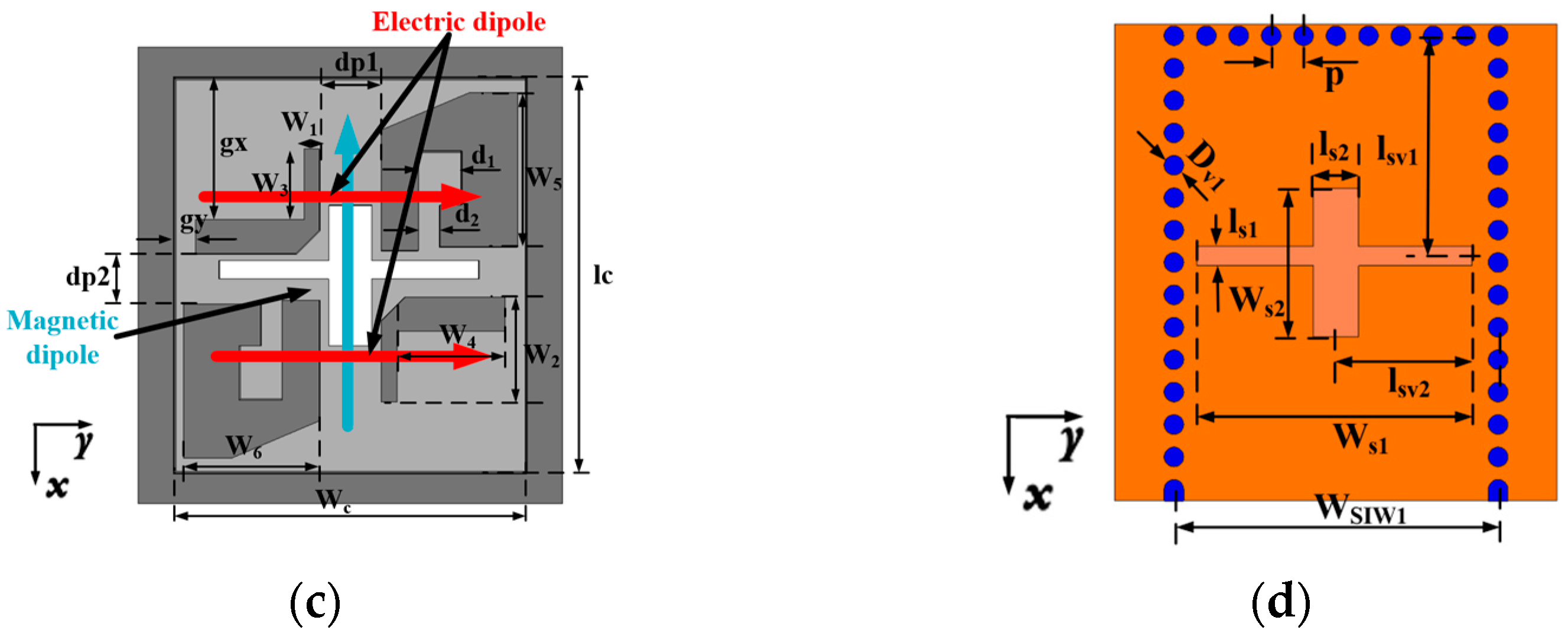
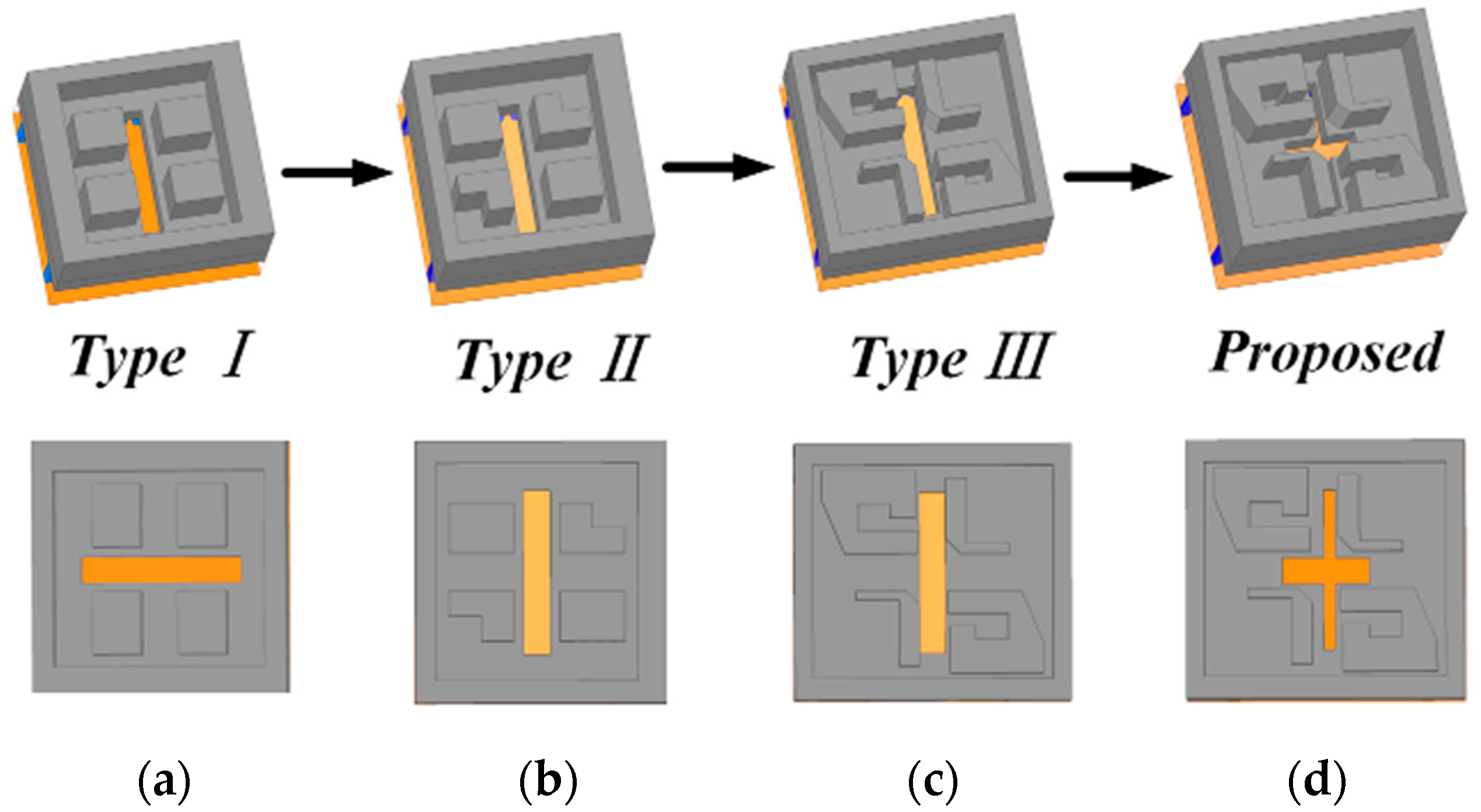
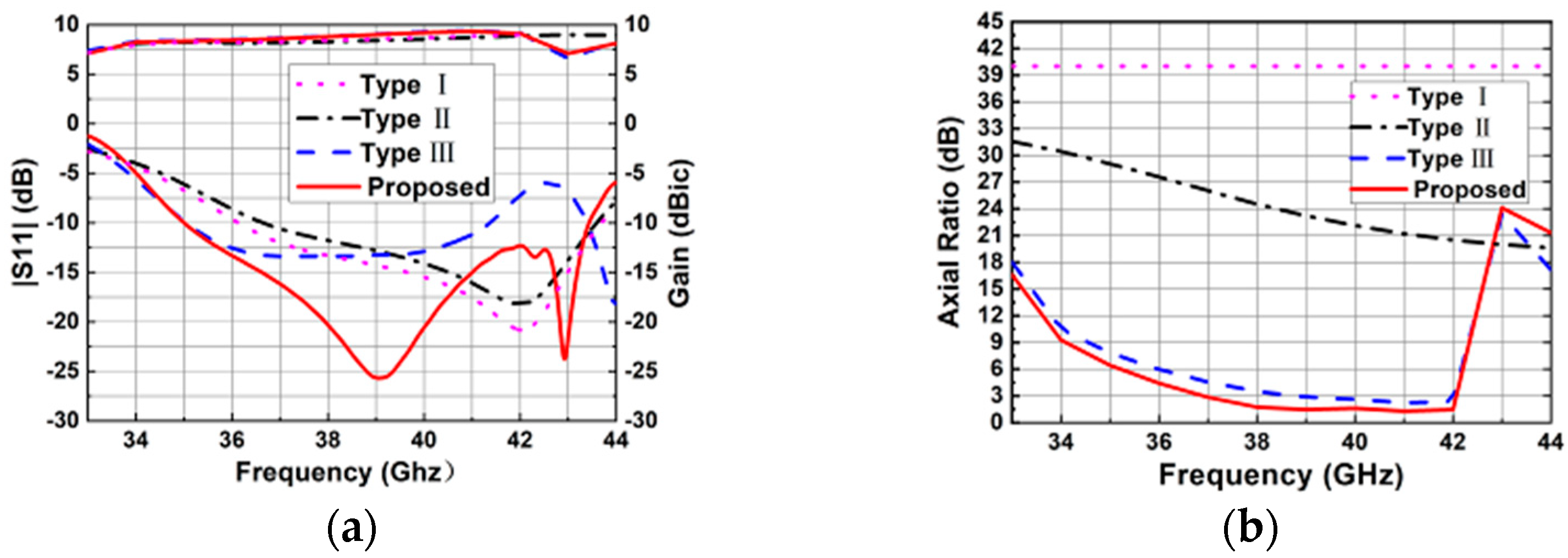

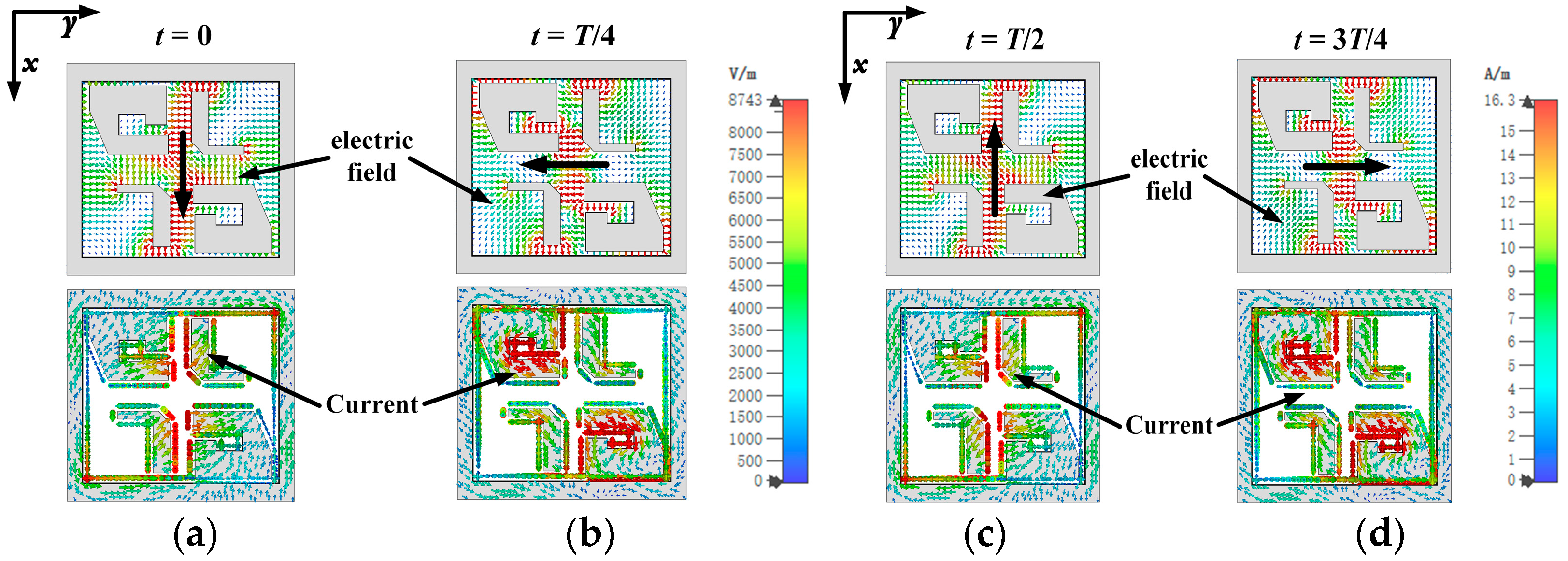


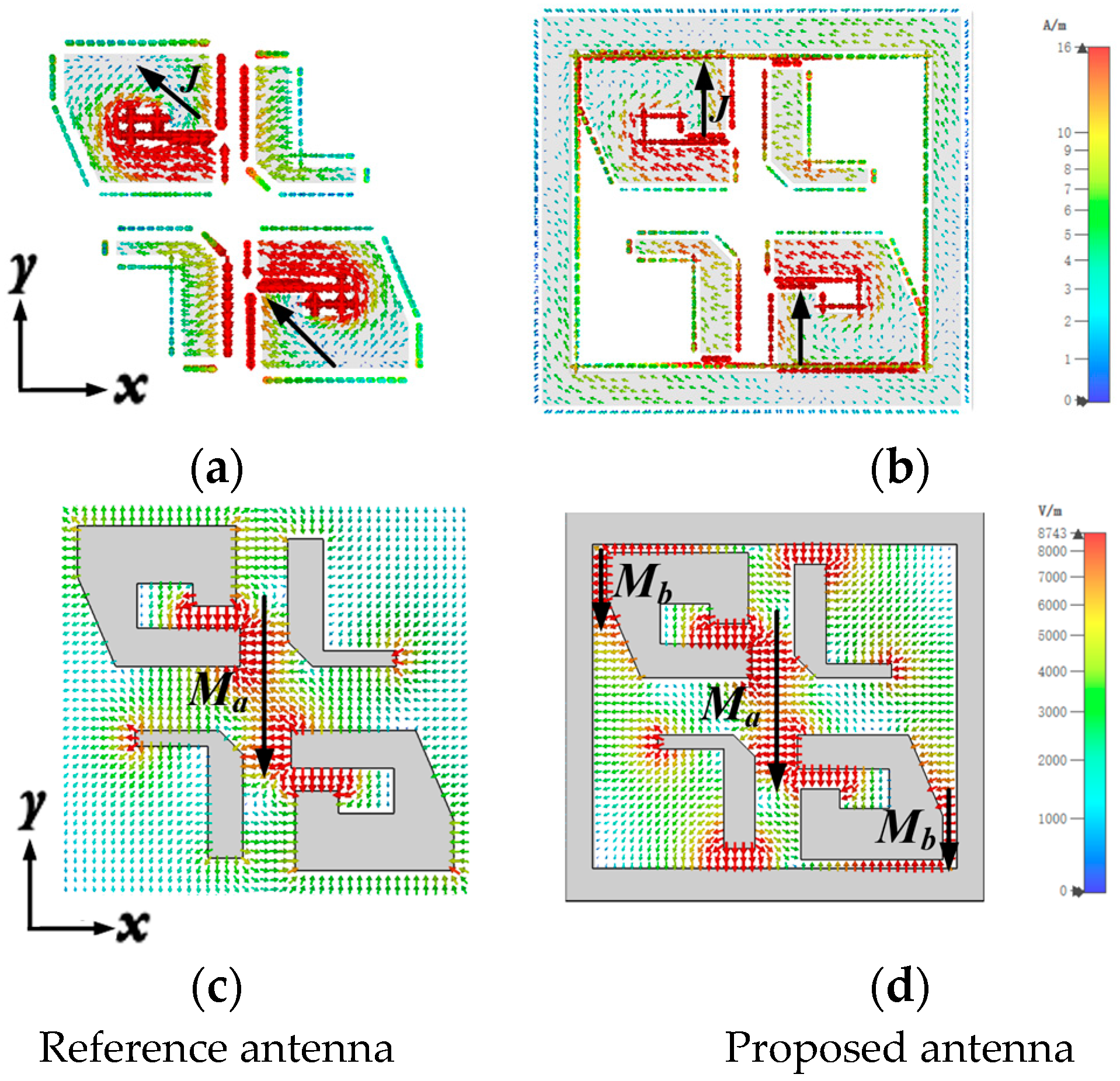


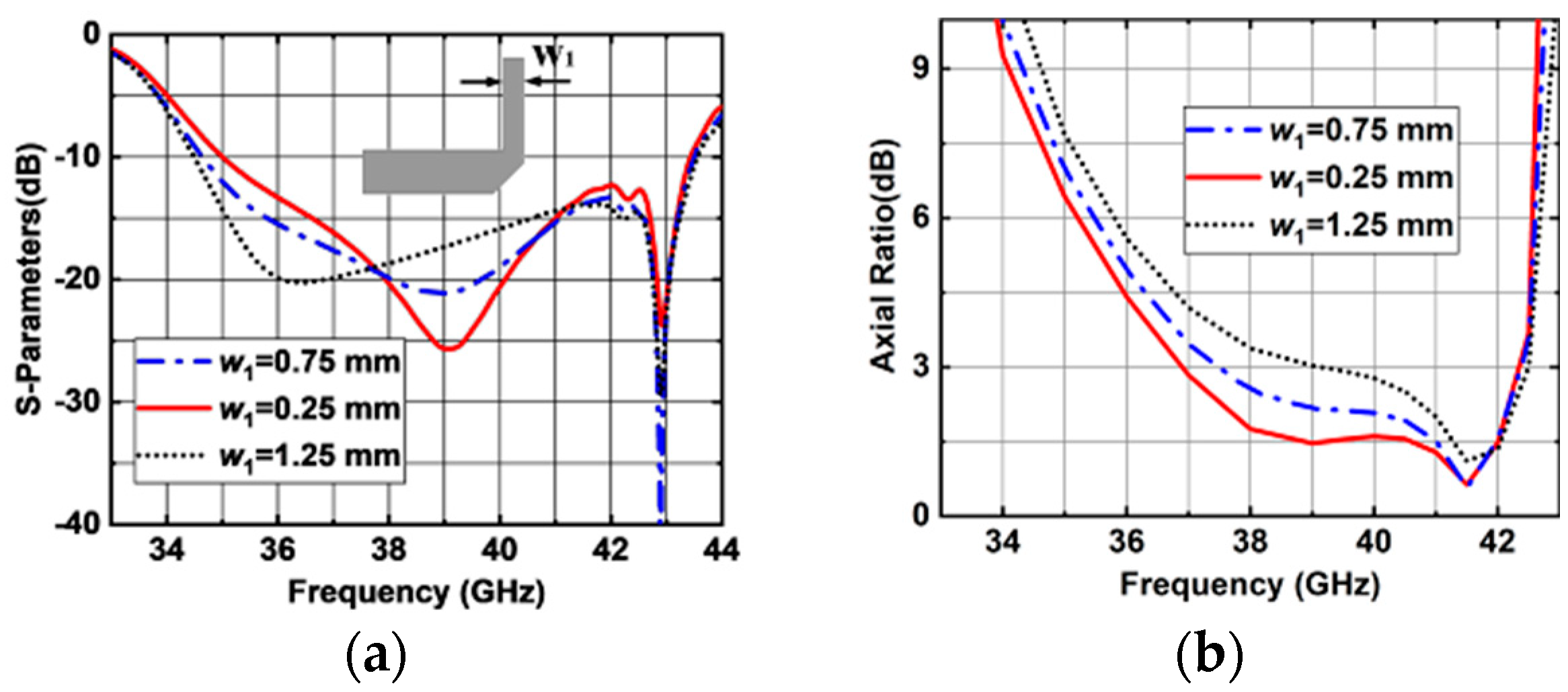

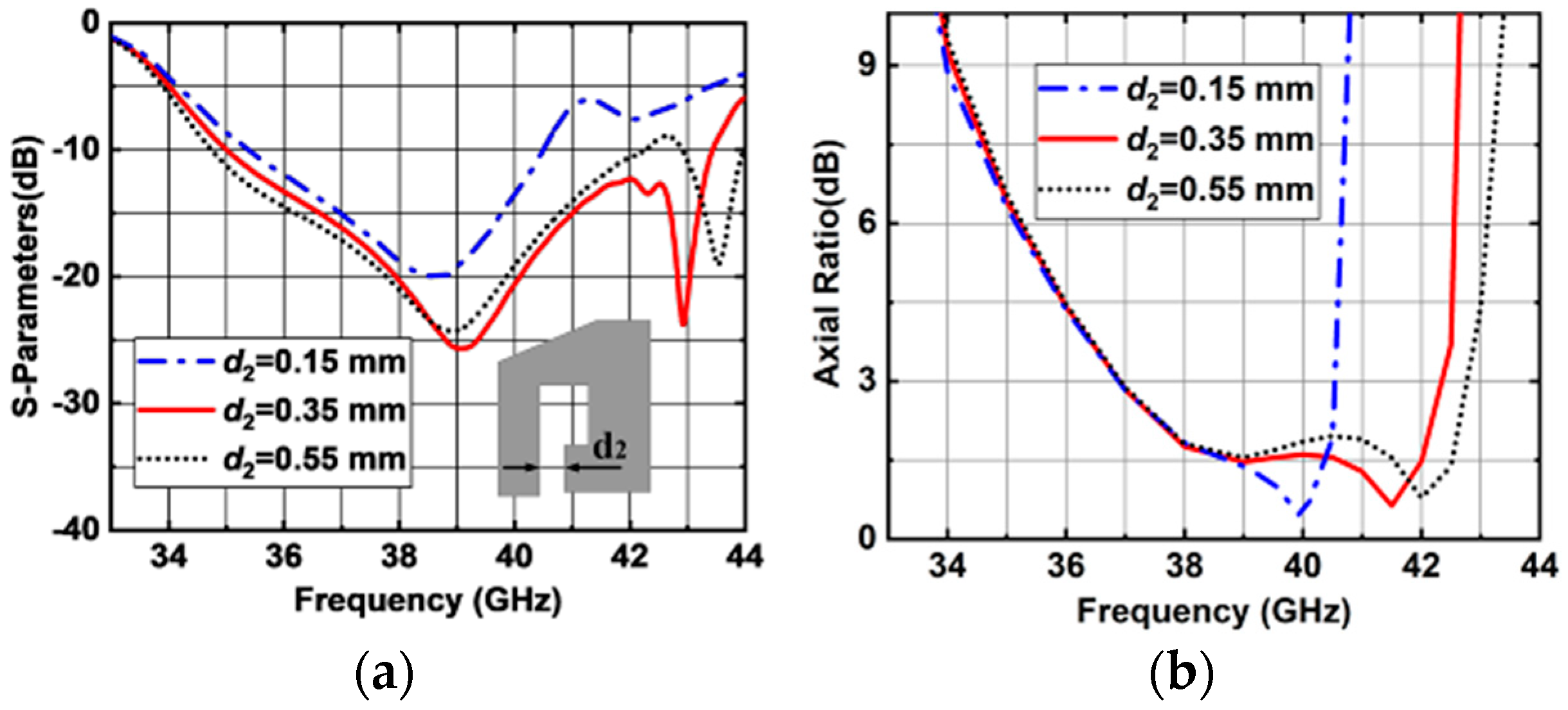


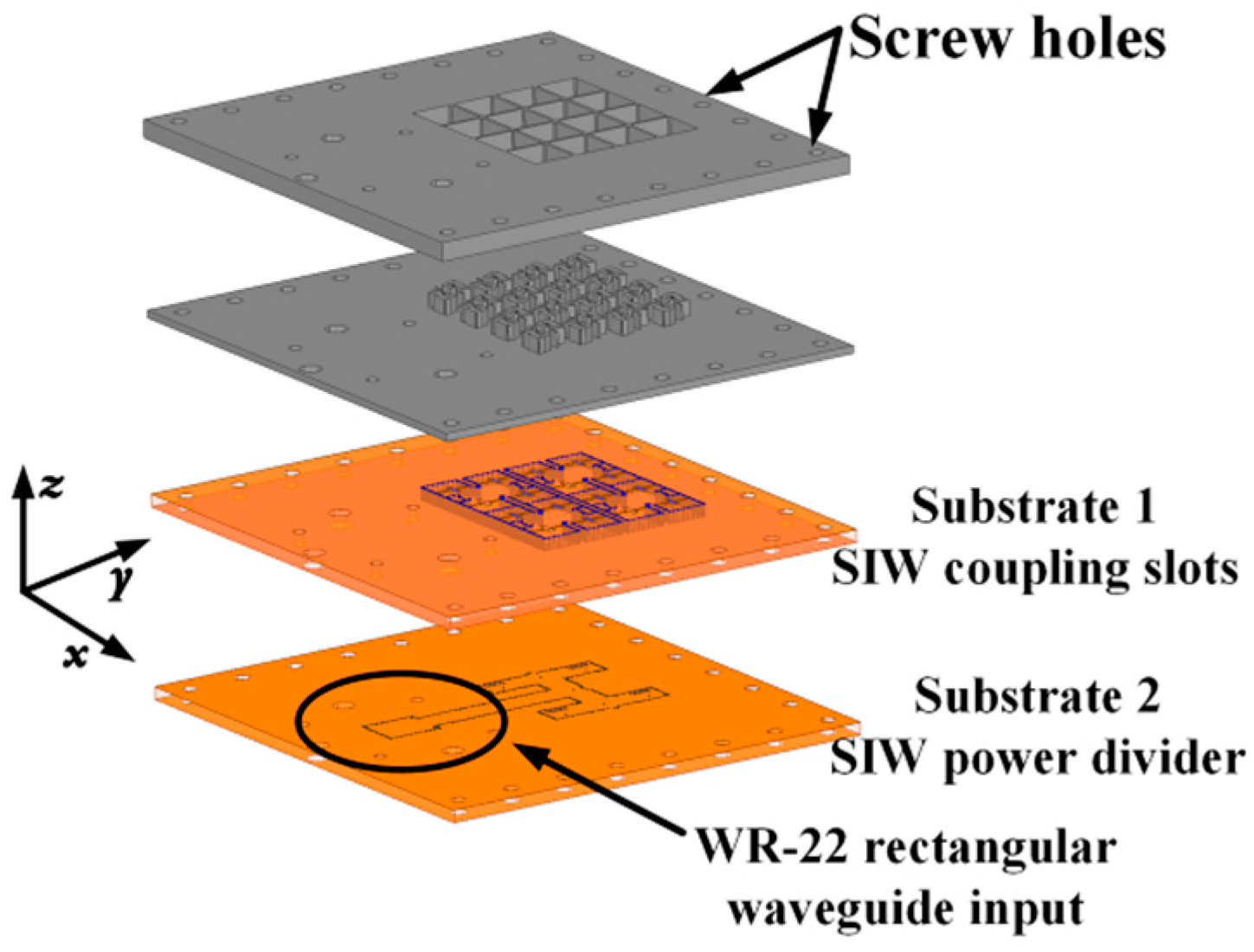



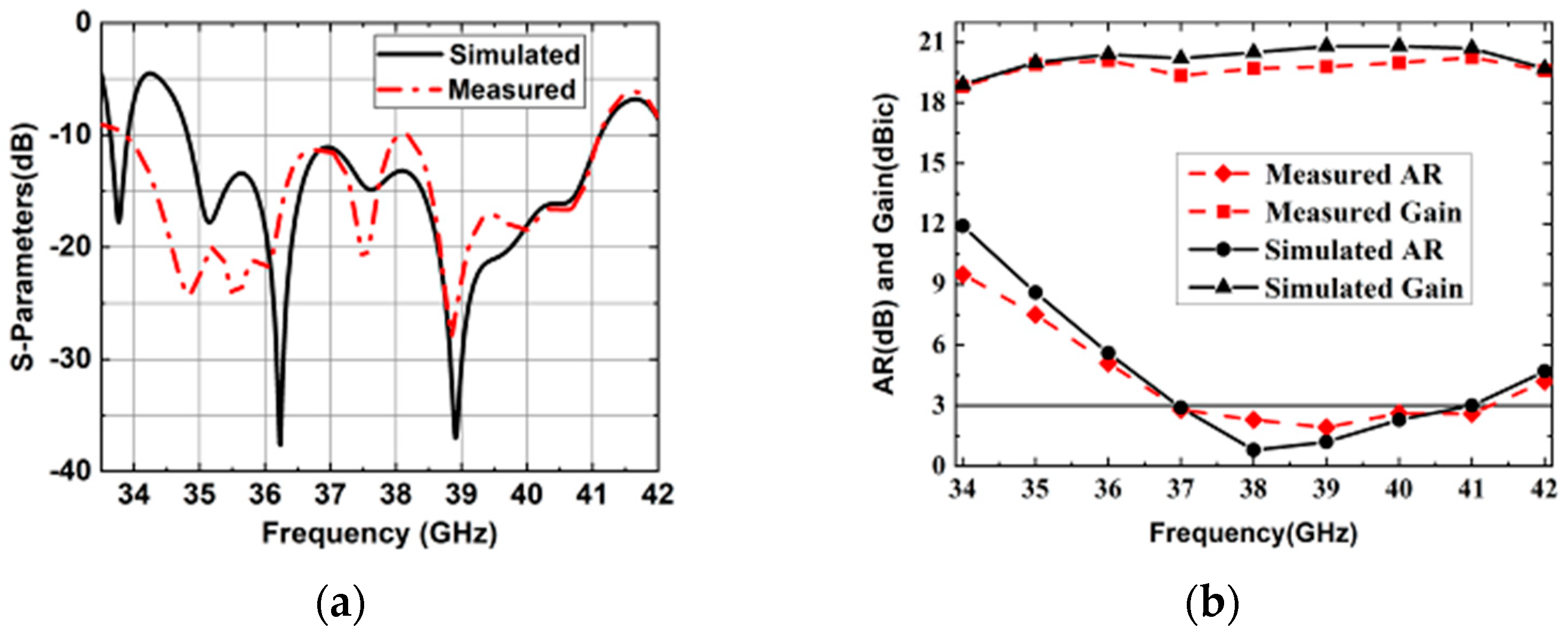

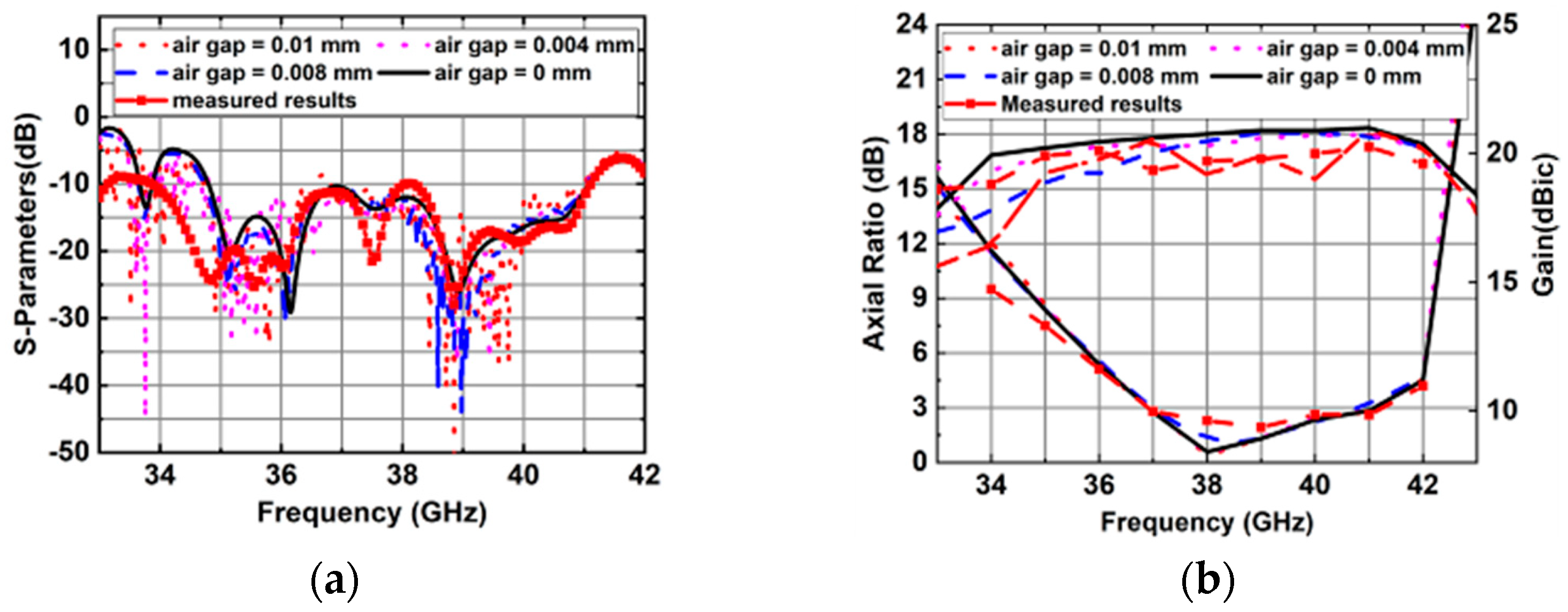
| Parameters | w1 | w2 | w3 | w4 | w5 | w6 | ws1 | ws2 | wsiw1 |
| Values | 0.25 | 1.7 | 1.15 | 1.75 | 2.48 | 2.2 | 4.25 | 2.3 | 5 |
| Parameters | wc | ls1 | ls2 | lsv1 | lsv2 | lc | hw | hg | hp |
| Values | 5.7 | 0.3 | 0.7 | 3.4 | 2.5 | 6.4 | 2.4 | 1 | 2 |
| Parameters | Δh | d1 | d2 | dp1 | dp2 | gx | gy | Dv1 | p |
| Values | 0.4 | 0.7 | 0.35 | 0.3 | 0.81 | 0.35 | 2.3 | 0.3 | 0.5 |
| Parameters | d3 | d4 | d5 | d6 | duy | dux | Dv2 | ws3 | wsv3 |
| Values | 0.45 | 4.15 | 2.8 | 1.43 | 6.15 | 6.82 | 0.8 | 2.7 | 2.2 |
| Parameters | wsiw2 | ls3 | lsv3 | lm | |||||
| Values | 4 | 1 | 0.8 | 1.2 |
| Ref. | No. of Element | Thickness (λ0) | f0 (GHz) | Type | Feeding Network | Imp. BW % | 3 db AR BW % | Radiation Efficiency % | Peak Gain (dBic) |
|---|---|---|---|---|---|---|---|---|---|
| [3] | 4 × 4 | 0.21 | 28.35 | Slot | Microstrip line | 28.6 | 14 | >65 | 18.2 |
| [4] | 4 × 4 | 0.40 | 60 | Helical | Microstrip line | 22 | 20 | n.a. | 15.2 |
| [6] | 4 × 4 | n.a. | 60 | Spiral | SIW | 14.1 | 21.1 | 87.1 | 19.5 |
| [9] | 4 × 4 | 0.30 | 30.5 | Parasitic patches | SIW | 27.7 | 28.5 | n.a. | 17.85 |
| [13] | 4 × 4 | 0.15 | 45 | ME-dipole | Microstrip line | >24.4 | 16 | n.a. | 18.8 |
| [18] | 4 × 4 | 0.02 | 28.63 | ME-dipole | Microstrip line | 21.83 | 5.9 | n.a. | 18.3 |
| [22] * | 8 × 8 | 2.20 | 31.5 | ME-dipole | Air-filled waveguide | 32.4 | n.a. | 72 | 27.1 |
| [23] | 4 × 8 | 2.19 | 90 | ME-dipole | GWG | 16.5 | 17 | n.a. | 23 |
| This work | 4 × 4 | 0.84 | 37.5 | ME-dipole | SIW | 19.2 | 10.3 | 83.2 | 20.3 |
Disclaimer/Publisher’s Note: The statements, opinions and data contained in all publications are solely those of the individual author(s) and contributor(s) and not of MDPI and/or the editor(s). MDPI and/or the editor(s) disclaim responsibility for any injury to people or property resulting from any ideas, methods, instructions or products referred to in the content. |
© 2025 by the authors. Licensee MDPI, Basel, Switzerland. This article is an open access article distributed under the terms and conditions of the Creative Commons Attribution (CC BY) license (https://creativecommons.org/licenses/by/4.0/).
Share and Cite
Xiao, J.; Wu, J.; Ye, Z.; Ding, T.; Han, C.; Ye, Q. A High-Gain Circularly Polarized Magnetoelectric Dipole Antenna Array for Millimeter-Wave Applications. Sensors 2025, 25, 3046. https://doi.org/10.3390/s25103046
Xiao J, Wu J, Ye Z, Ding T, Han C, Ye Q. A High-Gain Circularly Polarized Magnetoelectric Dipole Antenna Array for Millimeter-Wave Applications. Sensors. 2025; 25(10):3046. https://doi.org/10.3390/s25103046
Chicago/Turabian StyleXiao, Jun, Jing Wu, Zihang Ye, Tongyu Ding, Chongzhi Han, and Qiubo Ye. 2025. "A High-Gain Circularly Polarized Magnetoelectric Dipole Antenna Array for Millimeter-Wave Applications" Sensors 25, no. 10: 3046. https://doi.org/10.3390/s25103046
APA StyleXiao, J., Wu, J., Ye, Z., Ding, T., Han, C., & Ye, Q. (2025). A High-Gain Circularly Polarized Magnetoelectric Dipole Antenna Array for Millimeter-Wave Applications. Sensors, 25(10), 3046. https://doi.org/10.3390/s25103046





